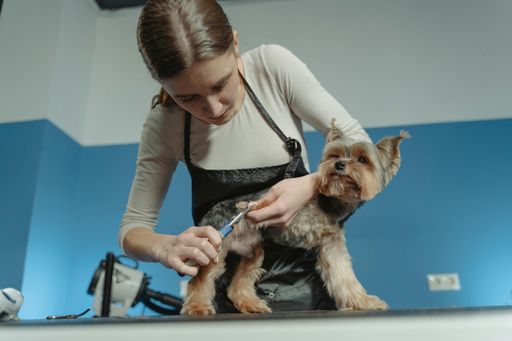As dog lovers, we’d do just about anything to keep our pups safe and happy. Whether it’s bolting after a bird, sneaking something dodgy off the floor, or getting hurt in the car, even the most careful dog owners know accidents can still happen. Thankfully, there are now loads of smart safety gadgets that can make a real difference - helping to prevent those scary moments and giving you serious peace of mind.
But here’s the big question: Will pet insurance actually help cover the cost of these safety must-haves?
When considering tools to help manage pet safety, it’s important to consider the needs specific to the pet. For supporting a dog with anxiety, for example, it’s worth checking whether your insurance plan covers any related costs, such as interactive pet cameras and behavioral therapy. Thoughtfully compare plans - take Spot pet insurance compared to Lemonade, for example, both offer up varying degrees of coverage for things like anxiety-related treatments and supplements. The right choice might come down to how comprehensive you want the cover to be when it comes to everyday emotional wellbeing - not just emergencies.
Let’s take a look at five of the most useful safety tools for your dog, what they actually do in real life, and whether your pet insurance plan is likely to pitch in. We’ll also throw in a few expert tips and budget-friendly ideas to help you keep your dog safe without blowing your budget.
1. GPS & Health Trackers (Like FitBark)
Why It’s a Game-Changer
These little gadgets do way more than just show you where your dog is. Many of them also keep tabs on your dog’s health - tracking sleep, activity, and even early warning signs of illness. If your dog is a master escape artist or just loves to explore, a GPS tracker can turn a potential nightmare into a quick reunion.

Surprising stat: Around 10 million pets go missing every year in the U.S., and fewer than a quarter are reunited with their families. A GPS tracker seriously improves your odds.
Will insurance cover it?
Most standard pet insurance plans don’t cover GPS trackers since they’re considered “non-medical.” That said, some premium wellness plans might cover part of the cost - especially if the tracker includes health and activity monitoring.
Worth it?
If your dog tends to wander or has medical issues, a tracker can save you a ton of stress - and possibly thousands in emergency costs.
2. Pet Camera with Two-Way Audio & Treat Tossing
Why It’s a Sanity-Saver (For You and Your Dog):
If your dog struggles with separation anxiety, this device can be a total lifesaver. You can check in on them while you’re out, talk to them through the mic, and even toss a treat remotely. It helps break up the loneliness and offers some comfort when you can’t be there.
Real-life perk: Studies show that interactive pet cameras can lower stress in dogs when they’re home alone.
“For dogs with anxiety, even small daily stressors can add up,” advises Ondrej Bina from Calm Shops, “calming chews are a gentle, non-invasive way to help soothe their nerves - especially when used alongside tools like pet cameras.”
Will insurance help out?
Typically, no - pet cameras fall under “home gadgets,” not medical gear. However, if your dog’s anxiety is bad enough to require vet treatment or behavior therapy, that part might be covered. A camera could be a handy tool to use alongside it.
Tip: Some wellness add-ons include annual reimbursements for behavior training, which can help offset the cost.
3. Crash-Tested Car Harnesses

Why It’s Non-Negotiable
We buckle ourselves in - our dogs need the same protection. In a car crash, an unrestrained dog becomes a high-speed projectile (yep, even a small dog can become a serious hazard). But here’s the kicker: only 16% of dog owners use proper restraints in the car.
Key info: Crash tests have shown that most harnesses fail. Look for ones tested by the Center for Pet Safety - brands like Sleepypod or Ruffwear have passed with flying colors.
Insurance?
They won’t cover the harness itself, but many car insurance policies offer up to $1,000 in pet injury coverage if your dog gets hurt in a crash.
Pro tip: Choose a harness with both a seat belt loop and a secure clip to the back of your dog’s harness for added safety.
4. Airline-Approved Carriers & Heavy-Duty Crates
Why They Matter:
Whether you're flying, heading out on a road trip, or preparing for an emergency evacuation, a secure carrier can save your dog’s life. Airlines require specific carriers, and crates are essential in chaotic or dangerous situations.
Quick stat: Over 500,000 pets are affected by natural disasters each year - many could be saved with better travel prep.
Does insurance cover them?
Usually not. But again, if your dog escapes and ends up injured, treatment might be covered. Still, why take the risk?
Smart buy: If you’re often on the road with your pup, look into crash-tested crates like Gunner Kennels - they’re pricey but built to last.
5. Pet Gates & Indoor Barriers
Why They’re Low-Key Lifesavers:
Busy households (or homes with multiple pets) can be full of hidden hazards - chocolate, cleaning supplies, cords, stairs. A good gate keeps curious noses out of trouble.
Scary stat: Human medications are the #1 cause of pet poisoning. A simple gate could prevent a terrifying (and expensive) emergency.
Covered by insurance?
Nope. But treating something like chocolate poisoning can run you anywhere from $250 to $3,000 depending on how much was eaten. Compared to that, a $50 gate is a no-brainer.
Quick tip: Go for pressure-mounted gates if you want flexibility, or hardware-mounted ones for long-term safety.
So... Are These Devices Worth It if Insurance Won’t Pay?
Absolutely. While most pet insurance policies won’t reimburse you for these safety tools, they can prevent the kind of emergencies that lead to massive vet bills. Think of them like a seatbelt - maybe you’ll never need it, but if you do, you’ll be glad it’s there.
Ways to Get the Most Out of Pet Insurance:
- Check your policy extras: Some plans include wellness or preventative care add-ons that might help with costs
- Keep receipts and records: If a safety device helps prevent an injury, it might help lower future premiums
- Use smart tech: Some insurers offer discounts if you use GPS or health trackers
At the end of the day, your dog’s safety is everything. And while insurance may not cover every gadget, the peace of mind (and potential savings) these tools offer is worth every penny.


















